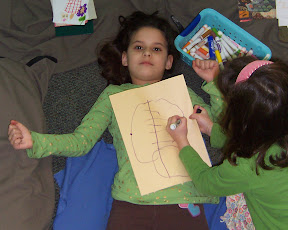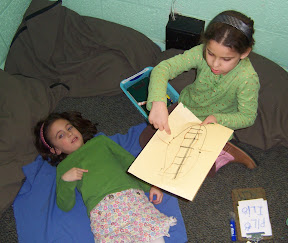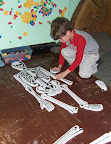Preschool play as assessment tool
By Peggy Ashbrook
Posted on 2009-06-01
 Preschool play can reflect young children’s knowledge about the natural world and the human interaction experiences they’ve had. I get to observe and learn what the children express through play when we finish our opening discussion and they move about the room.
Preschool play can reflect young children’s knowledge about the natural world and the human interaction experiences they’ve had. I get to observe and learn what the children express through play when we finish our opening discussion and they move about the room.
Twelve four-year olds and two teachers spend about 45 minutes in the Tree House Room where I set up materials more or less tied to the topic of the activity I am sharing that week. The plan was to observe, draw, and read about tadpoles borrowed from a local nature center. But the Fours have been playing “Doctor’s Office” in their classroom with dress-up uniforms, pretend medical tools such as stethoscopes and blood pressure cuffs, and plenty of tape for bandages on dolls. The doctor play was especially significant to the Four’s class because the school’s director and one child had casts on limbs for several months.

To support this learning, I put out x-rays on the light table, a foam human skeleton puzzle, and small clip boards, but they mostly create their own props, taking some plastic bugs and turtles, and drawing materials from the shelves. Tadpoles do get a little attention but the world the children re-create is most important to them.
A few children lie down on their backs. One child tucked some plastic bugs and turtles underneath the “patient’s” shirts. Enter the doctor:
Child 1: How is my little girl doing?
Child 2: She broke her leg and she had those bugs in her tummy. (Showing an x-ray drawing she made.)
Child 1 (in a quiet aside): I called you “little” girl because I’m pretending to be a doctor.
Later with the second patient:
Child 1: First we have to do an x-ray of what’s in his tummy. (Holds paper over the stomach and draws the turtle.)
Child 1: He has a poisonous turtle in his tummy. You’re going to have to open it because I don’t have the tools.
Child 2 (removing the turtle): It sure is a poisonous one!
This play is so delightful but that’s not all. I’m delighted to have a window into what children know about doctors and what x-rays are. They certainly know the difference between pretend and real, understand the need for cooperation between medical personnel, and can represent animals through drawing. We can work on “poisonous” turtles next week and the tadpoles will become more interesting when they develop legs.
 (Note that the child is making the skeleton “preschool” size without all the leg bones! This may have been his re-design or an accidental omission. The puzzle allows for several inventive adjustments to the human skeleton. At first I was concerned that the alternate assemblies might create some misconceptions about the human skeleton but when children find a few pieces leftover, or stand back and see the proportions, they usually self-correct. And other scientists often chime in and make changes, and we count the number of “sections” in our actual legs and arms.)
(Note that the child is making the skeleton “preschool” size without all the leg bones! This may have been his re-design or an accidental omission. The puzzle allows for several inventive adjustments to the human skeleton. At first I was concerned that the alternate assemblies might create some misconceptions about the human skeleton but when children find a few pieces leftover, or stand back and see the proportions, they usually self-correct. And other scientists often chime in and make changes, and we count the number of “sections” in our actual legs and arms.)
Share your science play stories by clicking on the word “Comments” below!
Peggy
Disclaimer: The views expressed in this blog post are those of the author(s) and do not necessarily reflect the official position of the National Science Teaching Association (NSTA).


